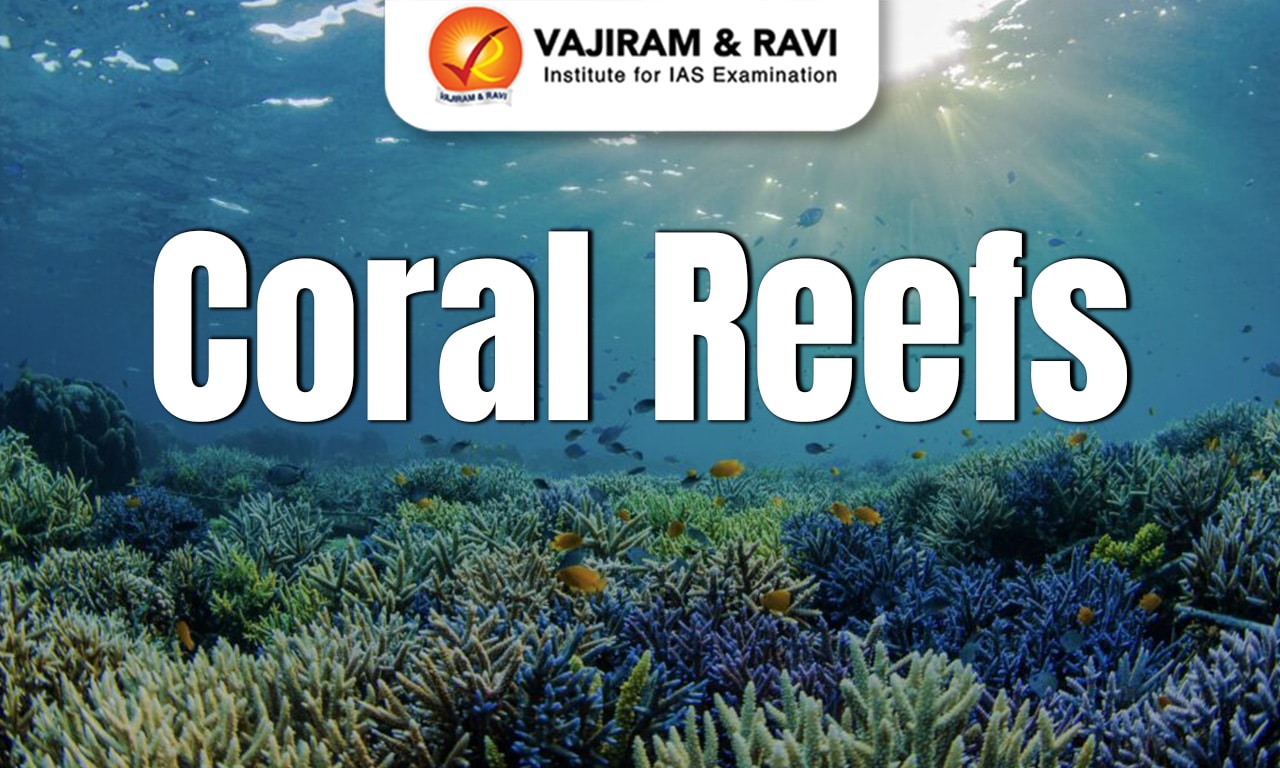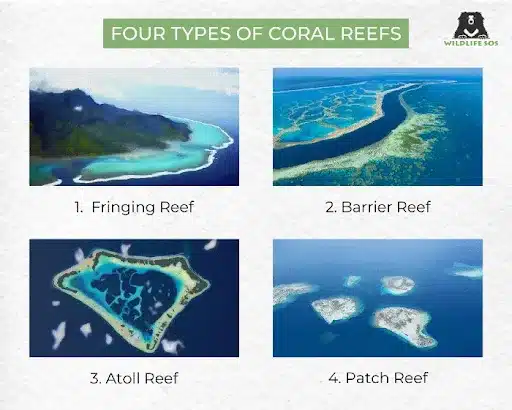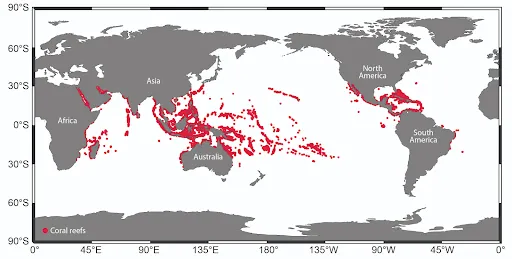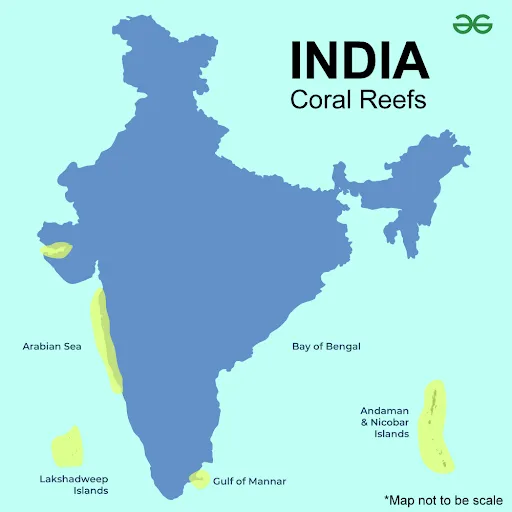Coral reefs are underwater ecosystems formed by colonies of coral polyps held together by calcium carbonate. It thrives in warm, shallow, and clear tropical waters. It is found in tropical regions like the Great Barrier Reef and India's Gulf of Mannar and Lakshadweep. Reefs provide food, coastal protection, and economic benefits through tourism and fisheries.
However, climate change, pollution, and overfishing threaten their survival. Rising sea temperatures cause coral bleaching, while ocean acidification weakens reefs. Conservation efforts like ICRI and India's legal measures are in place to protect corals. Further sustainable policies, climate action, and community participation are essential for reef protection.
Coral Reefs Definition
Coral reefs are vibrant underwater ecosystems built by reef-forming corals. These corals are marine invertebrates that share a symbiotic relationship with algae known as zooxanthellae. These corals secrete calcium carbonate (limestone) exoskeletons, which over time accumulate to form the massive, colorful, and biologically rich reefs
- Although they cover less than 0.1% of the ocean floor, coral reefs are vital to marine biodiversity, supporting around 25% of all marine species by providing habitat, food, and breeding grounds for numerous organisms.
- Coral reefs are often called the "rainforests of the sea".
- Coral reefs thrive in ocean conditions that contain minimal nutrients. They are most typically seen at shallow depths in tropical oceans, however, deep-water and cold-water coral reefs can also be found on smaller scales elsewhere.
Coral Reef Formation Conditions
Coral reefs require precise environmental conditions to flourish, including warm water temperatures between 23°C and 29°C, shallow depths for sunlight penetration, and stable salinity levels. Clear water and hard substrates are crucial for coral attachment and growth, ensuring a thriving ecosystem.
- Temperature: Optimal water temperatures vary from 23°C to 29°C because they have a restricted temperature tolerance.
- Depth: They normally thrive at depths of less than 50 meters, where sunlight penetration is enough for photosynthesis in algae.
- Salinity: Coral reefs thrive in salty water with stable salinity.
- Water Clarity: Clear waterways allow sunlight to reach the symbiotic algae for photosynthesis.
- Substrate: Hard substrates, such as volcanic rocks, provide the base for coral larvae to attach and grow.
Coral Reefs Types
Coral reefs are classified into four types based on structure and location: Fringing Reefs, Barrier Reefs, Atolls, and Patch Reefs. These formations vary from coastal reefs to offshore, lagoon-encircling, and isolated structures, each supporting diverse marine ecosystems and contributing to environmental stability.
- Fringing Reefs: These develop along the coastlines, separated from the shore by shallow lagoons.
- Barrier Reefs: These are found farther offshore, separated from land by deeper lagoons. The Great Barrier Reef is the largest example.
- Atolls: These are ring-shaped reefs that encircle a lagoon, often formed around sunken volcanic islands.
- Patch Reefs: Small, isolated reefs that grow from the ocean floor, usually within a lagoon, are Patch Reefs.
Coral Reefs Location
Coral reefs are predominantly located in tropical and subtropical oceans, between the Tropics of Cancer and Capricorn. More than 100 countries have coral reefs, with over half of them concentrated in six key nations: Australia, Indonesia, the Philippines, Papua New Guinea, Fiji, and the Maldives.
- Coral Triangle (Southeast Asia): The most biodiverse coral reef region, encompassing Indonesia, the Philippines, Malaysia, Papua New Guinea, Timor-Leste, and the Solomon Islands.
- Great Barrier Reef (Australia): The largest coral reef system, stretching 2,300 kilometres along Australia's northeast coast.
- Indian Ocean Reefs: Found in the Maldives, Seychelles, Madagascar, and Sri Lanka.
- Pacific Ocean Reefs: Include the extensive reefs of Fiji, the Marshall Islands, and French Polynesia.
- Caribbean Reefs: Major reefs are located near the Bahamas, Belize, and the Florida Keys.
- Red Sea Reefs: Known for their high salinity tolerance, found along the shores of Egypt, Sudan, and Saudi Arabia.
- Atlantic Ocean Reefs: Located in Bermuda, Brazil, and the Gulf of Mexico.
Coral Reefs in India
India's coral ecosystems are remarkably varied, extending across regions like the Gulf of Kutch, Gulf of Mannar, Palk Bay, Andaman and Nicobar Islands, and Lakshadweep Islands. These reefs, including fringing, patch, and barrier reefs, are adapted to various environmental conditions, supporting rich marine biodiversity.
- Gulf of Kutch: These corals are characterized by fringing reefs and are adapted to extreme tidal fluctuations and high salinity.
- Gulf of Mannar: These are home to extensive fringing reefs with rich biodiversity, including over 3,600 marine species. It is designated as a Biosphere Reserve, protecting various coral species, sea turtles, and marine mammals.
- Palk Bay corals are known for their shallow fringing reefs. This area experiences high sedimentation, making the corals more resistant to environmental stress. These reefs support traditional fishing communities.
- Andaman and Nicobar Islands contain extensive fringing reefs, patch reefs, and barrier reefs, making it one of India's most significant coral ecosystems. These reefs are highly diverse, sheltering species such as clownfish, giant clams, and reef sharks.
- Lakshadweep Islands feature atolls and coral banks, with a unique marine ecosystem distinct from the mainland. The reefs here are vital for local livelihoods, supporting tuna fisheries and seaweed cultivation.
Coral Reefs Importance
Coral reefs are essential to the economy, environment, and cultural heritage of millions globally. They provide food and income through fisheries and tourism, protect coastlines from erosion, and support marine biodiversity. Coral reefs also hold cultural importance and contribute to medical advancements through life-saving compounds.
Coral Reefs Economic Importance
Coral reefs play a crucial role in sustaining livelihoods, generating revenue, and supporting food security for millions worldwide. Their contributions span multiple sectors, from fisheries to tourism, making them vital to many coastal and island economies.
- Food: Coral reefs are a primary food source for about 500 million people, particularly in small island nations and coastal communities.
- For example, in Southeast Asia, nearly 25% of all fish caught depend on healthy coral reefs.
- Jobs: They support employment in fishing, tourism, and recreation.
- For example, The Great Barrier Reef alone generates approximately $6.4 billion annually from tourism and supported 64,000 jobs in 2015-16.
- Tourism: Coral reefs attract millions of tourists, contributing significantly to local economies.
- For example, Global coral reef-related tourism is estimated to be around $36 billion annually, benefiting countries like the Maldives and Australia.
Coral Reefs Environmental Importance
Coral reefs serve as vital ecosystems that support marine life, protect coastlines, and sustain biodiversity. Their role extends beyond marine habitats, offering natural defences against coastal erosion and climate-related threats.
- Habitat: Coral reefs are home to about 25% of all marine species, including over 4,000 species of fish and numerous invertebrates.
- Shoreline Protection: Reefs reduce wave energy by up to 97%, protecting coastal communities from storms, erosion, and tsunamis. This natural defence is crucial for nations vulnerable to rising sea levels.
- Biodiversity: Hosting around 800 species of hard corals, coral reefs maintain marine biodiversity, ensuring the balance of marine ecosystems.
Coral Reefs Cultural Importance
Coral reefs hold deep cultural and historical significance, from preserving ancient artifacts to influencing indigenous practices.
- History: Coral reefs are living museums, preserving historical shipwrecks and ancient human artefacts. For instance, coral growth on ancient shipwrecks in the Caribbean provides valuable insights into maritime history.
- Heritage: In the Pacific Islands, coral reefs are deeply linked to cultural identity and traditions, playing a role in spiritual practices, navigation, and community life.
Coral Reefs Medicinal Importance
Coral reef organisms are sources of life-saving medicines, including anti-cancer compounds, anti-inflammatory drugs, and antibiotics. For example, the Caribbean Sea sponge has contributed to the development of the HIV drug AZT (azidothymidine).
Coral Reefs Threats
Coral reefs are threatened by climate change, pollution, overfishing, and coastal development. Rising ocean temperatures, acidification, and storms damage corals, while pollutants like plastics and chemical runoff hinder growth. Destructive fishing and unregulated tourism further degrade these ecosystems, threatening their future.
Coral Reef Threats from Climate Change
Coral reefs are highly sensitive to climate change, with rising temperatures, sea levels, and extreme weather events threatening their survival.
- Ocean Warming: Warmer ocean temperatures cause coral bleaching, which can lead to coral death. For example, the 2016 El Niño event led to the bleaching of 29% of the Great Barrier Reef.
- Sea Level Rise: Rising sea levels increase sedimentation, smothering corals and blocking sunlight needed for photosynthesis.
- Increased Storm Intensity: Climate change leads to stronger storms, causing physical damage to coral structures.
Coral Reef Threats from Pollution
Pollutants like plastic waste, chemical runoff and rising greenhouse gas emissions are some of the biggest threats to coral reefs, disrupting their delicate balance hindering their growth and endangering marine ecosystems.
- Marine Debris: Plastics and other debris physically damage corals and introduce toxins. In the Pacific Ocean, the Great Pacific Garbage Patch poses a severe threat to coral ecosystems.
- Ocean Acidification: Higher carbon dioxide levels decrease ocean pH, weakening coral skeletons and slowing growth. According to the National Oceanic and Atmospheric Administration, ocean acidity has increased by 30% since the Industrial Revolution.
- Nutrient Pollution: Runoff containing fertilizers causes algal blooms, blocking sunlight and depleting oxygen, suffocating corals.
Coral Reef Threats from Overfishing
Unsustainable and disruptive fishing practices pose a major threat to coral reef ecosystems, disrupting food chains and damaging reef structures.
- Overfishing: Depletes key species, disrupting the ecological balance and leading to algae overgrowth on reefs.
- Destructive Fishing Practices: Methods like blast fishing and cyanide fishing physically destroy coral structures.
Coral Reef Threats from Coastal Development
Human activities such as construction and land reclamation disrupt reef ecosystems and cause increased sedimentation, making it harder for corals to survive and grow.
- Habitat Destruction: Coastal construction and land reclamation destroy coral habitats.
- Sedimentation: Increased sediment from deforestation and construction reduces water clarity, hindering coral photosynthesis.
Coral Reef Threats from Human Activities
Unsustainable tourism, resource extraction, and careless recreational practices put immense pressure on the coral ecosystem.
- Tourism and Recreation: Unregulated tourism leads to coral damage from boat anchors, trampling, and pollution.
- Marine Mining: Extraction of minerals and sand damages coral habitats and alters local ecosystems.
Coral Reef Conservation Efforts
Global and national initiatives are crucial for coral reef conservation. International efforts like the Coral Triangle Initiative and UNESCO World Heritage Sites focus on safeguarding reefs through partnerships, monitoring, and sustainable management.
In India, legal frameworks such as the Wildlife Protection Act, the Environment Protection Act, and Marine Protected Areas help preserve coral ecosystems and regulate harmful activities. These initiatives promote conservation, research, and sustainable use of marine resources.
Global Commitments for Coral Reef Conservation
International efforts like the Coral Triangle Initiative and the International Coral Reef Initiative focus on coral reef conservation, while the Global Coral Reef Monitoring Network monitors reef health. Aichi Target 10 addresses climate-related threats, and UNESCO World Heritage Sites protect key reef ecosystems.
- Coral Triangle Initiative: It is a multilateral partnership of six countries working together to sustain extraordinary marine and coastal resources.
- International Coral Reef Initiative (ICRI): Promotes the sustainable management of coral reefs worldwide.
- Global Coral Reef Monitoring Network (GCRMN): It is an operational network of ICRI with the primary task of reporting on the condition of the world’s coral reefs.
- Aichi Target 10: It concerns reducing pressures on coral reefs and other vulnerable ecosystems impacted by climate change or ocean acidification
- UNESCO World Heritage Sites: Protects key coral reef locations through international recognition and conservation.
Initiatives for Coral Reef Conservation in India
India has implemented several measures like Wild Life Protection Act, 1972, the Environment Protection Act, 1986, the Coastal Regulation Zone, and Marine Protected Area to protect coral reefs and support research and awareness efforts.
- Wild Life Protection Act, 1972: In July 2001, all hard corals were included in Schedule I, providing the highest level of legal protection.
- Environment Protection Act, 1986 (EPA): Empowers the Central Government to protect marine environments and control marine pollution.
- Coastal Regulation Zone (CRZ) Notification 1991: Explicitly prohibits coral mining in India, safeguarding coastal and marine biodiversity.
- Coastal Regulation Zone (CRZ) Notification 2011 and the Island Protection Zone (IPZ) Notification 2011 regulate the development activities along the Sea coast and tidal influenced water bodies.
- Marine Protected Areas (MPAs): Designated zones to preserve marine habitats, including coral reefs, while regulating fishing and tourism activities.
- Coral Reef Monitoring: Regular assessments of reef health and biodiversity to inform conservation strategies.
- National Coral Reef Research Centre: Conducts research and raises awareness about coral reef conservation.
Coral Reefs Way Forward
To ensure the survival of coral reefs, a multi-dimensional approach is essential, integrating scientific research, policy interventions, and community participation. Strengthening conservation efforts can not only preserve biodiversity but also sustain the livelihoods of millions who depend on reef ecosystems.
- Enhanced Policy Frameworks: Implement stricter regulations on overfishing, pollution, and coastal development. Strengthening marine protected areas and enforcing environmental laws are vital.
- Climate Change Mitigation: Reducing carbon emissions and transitioning to renewable energy sources are crucial to combat coral bleaching and ocean acidification.
- Restoration and Rehabilitation: Techniques like coral gardening and artificial reefs aid in regenerating damaged ecosystems, enhancing reef resilience.
- Best Practices like Biorock technology, which uses low-voltage electrical currents to stimulate the deposition of calcium carbonate, accelerating coral growth and improving reef restoration efforts.
- Community Involvement and Education: Engaging locals ensures sustainable practices, while awareness campaigns promote responsible tourism.
- International Collaboration: Global partnerships are needed to tackle transboundary issues like marine pollution and climate change.
Coral Reefs UPSC PYQs
Q1. Which of the following have coral reefs?
- Andaman and Nicobar Islands
- Gulf of Kachchh
- Gulf of Mannar
- Sunderbans
Select the correct answer using the code given below. (UPSC Prelims 2014)
(a) 1,2 and 3 only
(b) 2 and 4 only
(c) 1 and 3 only
(d) 1, 2,3 and 4
Ans: (a)
Q2. The scientific view is that the increase in global temperature should not exceed 2°C above pre-industrial level. If the global temperature increases beyond 3°C above the pre-industrial level, what can be its possible impact/impacts on the world?
- Terrestrial biosphere tends toward a net carbon source.
- Widespread coral mortality will occur.
- All the global wetlands will permanently disappear.
- Cultivation of cereals will not be possible anywhere in the world.
Select the correct answer using the code given below. (UPSC Prelims 2014)
(a) 1 only
(b) 1 and 2 only
(c) 2, 3 and 4 only
(d) 1, 2, 3 and 4
Ans: (b)
Q3. “Biorock technology” is talked about in which one of the following situations? (UPSC Prelims 2022)
(a) Restoration of damaged coral reefs
(b) Development of building materials using plant residue
(c) Identification of areas for exploration/extraction of shale gas
(d) Providing salt licks for wild animals in forests/protected areas
Ans: (a)
Q4. Consider the following statements:
- Most of the world’s coral reefs are in tropical waters.
- More than one-third of the world’s coral reefs are located in the territories of Australia, Indonesia and the Philippines.
- Coral reefs host far more number of animal phyla than those hosted by tropical rainforests.
Which of the statements given above is/are correct? (UPSC Prelims 2018)
(a) 1 and 2 only
(b) 3 only
(c) 1 and 3 only
(d) 1, 2 and 3
Ans: (c)
Q5. Assess the impact of global warming on coral life systems with examples. (UPSC Mains 2019)
Last updated on December, 2025
→ Check out the latest UPSC Syllabus 2026 here.
→ Join Vajiram & Ravi’s Interview Guidance Programme for expert help to crack your final UPSC stage.
→ UPSC Mains Result 2025 is now out.
→ UPSC Notification 2026 is scheduled to be released on January 14, 2026.
→ UPSC Calendar 2026 is released on 15th May, 2025.
→ The UPSC Vacancy 2025 were released 1129, out of which 979 were for UPSC CSE and remaining 150 are for UPSC IFoS.
→ UPSC Prelims 2026 will be conducted on 24th May, 2026 & UPSC Mains 2026 will be conducted on 21st August 2026.
→ The UPSC Selection Process is of 3 stages-Prelims, Mains and Interview.
→ UPSC Result 2024 is released with latest UPSC Marksheet 2024. Check Now!
→ UPSC Prelims Result 2025 is out now for the CSE held on 25 May 2025.
→ UPSC Toppers List 2024 is released now. Shakti Dubey is UPSC AIR 1 2024 Topper.
→ UPSC Prelims Question Paper 2025 and Unofficial Prelims Answer Key 2025 are available now.
→ UPSC Mains Question Paper 2025 is out for Essay, GS 1, 2, 3 & GS 4.
→ UPSC Mains Indian Language Question Paper 2025 is now out.
→ UPSC Mains Optional Question Paper 2025 is now out.
→ Also check Best IAS Coaching in Delhi
Coral Reefs FAQs
Q1. What do coral reefs explain?+
Q2. Why is coral reef important?+
Q3. What are the 4 types of coral reefs?+
Q4. What are the 5 dangers to coral reefs?+
Q5. What causes coral disease?+




















